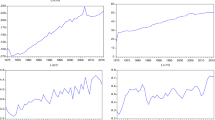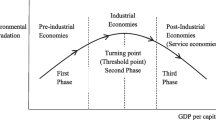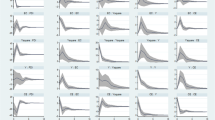Abstract
This research article aims to investigate the moderating role of financial development in Environmental Kuznets Curve (EKC) in the context of Malaysia for the period 1970–2016. As the time series variables are integrated of different order therefore, Auto-Regressive Distributed Lag (ARDL) model has been employed to estimate the long-run equilibrium relationship among the variables. The results indicate that EKC does exist for Malaysia and financial development has negative impact on carbon emission. Moreover, financial development is found to have significant moderating impact on income environment relation. More financial development brings early turning point of the EKC. The results recommend that financial development can be used as one of the policy measures to reduce the environmental cost of economic growth in Malaysia.




Similar content being viewed by others

References
Abid M (2017) Does economic, financial and institutional developments matter for environmental quality? A comparative analysis of EU and MEA countries. J Environ Manag 188:183–194
Al Sayed AR, Sek SK (2013) Environmental Kuznets curve: evidences from. Appl Math Sci 7(22):1081–1092
Apergis N, Ozturk I (2015) Testing environmental Kuznets curve hypothesis in Asian countries. Ecol Indic 52:16–22
Arrow K, Bolin B, Costanza R, Dasgupta P, Folke C, Holling CS et al (1995) Economic growth, carrying capacity, and the environment. Ecol Econ 15(2):91–95
Aslanidis N (2009) Environmental Kuznets Curves for Carbon Emissions: A Critical Survey. Working Paper No 51. Spain: University of Teramo
Aubourg RW, Good DH, Krutilla K (2008) Debt, democratization, and development in Latin America: how policy can affect global warming. J Pol Anal Manag 27(1):7–19
Beckerman W (1992) Economic growth and the environment: whose growth? Whose environment? World Dev 20(4):481–496
Begum RA, Sohag K, Abdullah SMS, Jaafar M (2015) CO2 emissions, energy consumption, economic and population growth in Malaysia. Renew Sust Energ Rev 41:594–601
Bradford DF, Schlieckert R, & Shore SH (2000) The environmental Kuznets curve: exploring a fresh specification (No. w8001). National Bureau of Economic Research
Brown RL, Durbin J, & Evans JM (1975) Techniques for testing the constancy of regression relationships over time. Journal of the Royal Statistical Society: Series B (Methodological) 37(2):149-163
Chow GC, Li J (2014) Environmental Kuznets curve: conclusive econometric evidence for CO2. Pac Econ Rev 19(1):1–7
Chowdhury RR, Moran EF (2012) Turning the curve: a critical review of Kuznets approaches. Appl Geogr 32(1):3–11
Claessens S, Feijen E (2007) Financial sector development and the millennium development goals. World Bank Working Paper No. 89
Cole MA, Elliott RJ (2005) FDI and the capital intensity of “dirty” sectors: a missing piece of the pollution haven puzzle. Rev Dev Econ 9(4):530–548
Costantini V, Martini C (2010) A modified environmental Kuznets curve for sustainable development assessment using panel data. Int J Glob Environ Issues 10(1):84–122
Dasgupta S, Laplante B, Mamingi N (2001) Pollution and capital markets in developing countries. J Environ Econ Manag 42(3):310–335
Dasgupta S, Hamilton K, Pandey KD, Wheeler D (2006) Environment during growth: accounting for governance and vulnerability. World Dev 34(9):1597–1611
Dickey DA, & Fuller WA (1981) Likelihood ratio statistics for autoregressive time series with a unit root. Econometrica: Journal of the Econometric Society :1057–1072
Dinda S (2004) Environmental Kuznets curve hypothesis: a survey. Ecol Econ 49(4):431–455
Engle R, Granger C (2001) Co-integration and error-correction: representation, estimation, and testing. Econ Soc Monogr 33:145–172
Fodha M, Zaghdoud O (2010) Economic growth and pollutant emissions in Tunisia: an empirical analysis of the environmental Kuznets curve. Energy Policy 38(2):1150–1156
Gill AR, Viswanathan KK, & Hassan S (2018) The Environmental Kuznets Curve (EKC) and the environmental problem of the day. Renewable and Sustainable Energy Reviews 81:1636–1642
Gill AR, Viswanathan KK, & Hassan S (2018) A test of environmental Kuznets curve (EKC) for carbon emission and potential of renewable energy to reduce green house gases (GHG) in Malaysia. Environment, development and sustainability 20(3):1103–1114
Grossman, Krueger (1995) Economic environment and the economic growth. Q J Econ 110(2):353–377
Jalil A, Feridun M (2011) The impact of growth, energy and financial development on the environment in China: a cointegration analysis. Energy Econ 33(2):284–291
Johansen S (1995) Likelihood-based inference in cointegrated vector autoregressive models. Oxford University Press, Oxford
Katircioğlu ST, Taşpinar N (2017) Testing the moderating role of financial development in an environmental Kuznets curve: empirical evidence from Turkey. Renew Sust Energ Rev 68:572–586
Kwiatkowski D, Phillips PC, Schmidt P, Shin Y (1992) Testing the null hypothesis of stationarity against the alternative of a unit root: how sure are we that economic time series have a unit root? J Econ 54(1-3):159–178
Lau L-S, Choong C-K, Eng Y-K (2014) Investigation of the environmental Kuznets curve for carbon emissions in Malaysia: do foreign direct investment and trade matter? Energy Policy 68:490–497
Lee J-M, Chen K-H, Cho C-H (2016) The relationship between CO2 emissions and financial development. The Singapore Economic Review 60(5):1550117
MacKinnon JG (1990) “Critical Values for Cointegration Tests”. Canada: Department of Economics, Queen’s University
Managi S, Jena PR (2008) Environmental productivity and Kuznets curve in India. Ecol Econ 65(2):432–440
Nasreen S, Anwar S, Ozturk I (2017) Financial stability, energy consumption and environmental quality: evidence from South Asian economies. Renew Sust Energ Rev 67:1105–1122
Ozturk I, Acaravci A (2013) The long-run and causal analysis of energy, growth, openness and financial development on carbon emissions in Turkey. Energy Econ 36:262–267
Panayotou T (1993) Empirical tests and policy analysis of environmental degradation at different stages of economic development (No. 992927783402676). International Labour Organization
Panayotou T (1995) Environmental degradation at different stages of economic development, Beyond Rio: the environmental crises and sustainable livelihoods in the Third World. Macmillan Press, London
Pesaran MH, Shin Y (1998) An autoregressive distributed-lag modelling approach to cointegration analysis. Econ Soc Monogr 31:371–413
Pesaran MH, Shin Y, Smith RJ (2001) Bounds testing approaches to the analysis of level relationships. J Appl Econ 16(3):289–326
Phillips PC, Hansen BE (1990) Statistical inference in instrumental variables regression with I (1) processes. Rev Econ Stud 57(1):99–125
Raymond L (2004) Economic growth as environmental policy? Reconsidering the environmental Kuznets curve. J Public Policy 24(03):327–348
Saboori B, Sulaiman J (2013) Environmental degradation, economic growth and energy consumption: evidence of the environmental Kuznets curve in Malaysia. Energy Policy 60:892–905
Saboori B, Sulaiman J, Mohd S (2012) Economic growth and CO 2 emissions in Malaysia: a cointegration analysis of the environmental Kuznets curve. Energy Policy 51:184–191
Sadorsky P (2010) The impact of financial development on energy consumption in emerging economies. Energy Policy 38(5):2528–2535
Sadorsky P (2011) Financial development and energy consumption in Central and Eastern European frontier economies. Energy Policy 39(2):999–1006
Shafik N (1994) Economic development and environmental quality: an econometric analysis. Oxford economic papers 46(4):757–774
Shafik N, Bandyopadhyay S (1992) Economic growth and environmental quality: time-series and cross-country evidence, vol 904. World Bank Publications, Washington, DC.
Shahbaz M, Lean HH (2012) Does financial development increase energy consumption? The role of industrialization and urbanization in Tunisia. Energy Policy 40:473–479
Shahbaz M, Hye QMA, Tiwari AK, Leitão NC (2013) Economic growth, energy consumption, financial development, international trade and CO2 emissions in Indonesia. Renew Sust Energ Rev 25:109–121
Stern DI (2004) The rise and fall of the environmental Kuznets curve. World Dev 32(8):1419–1439
Tamazian A, Rao BB (2010) Do economic, financial and institutional developments matter for environmental degradation? Evidence from transitional economies. Energy Econ 32(1):137–145
Tamazian A, Chousa JP, Vadlamannati KC (2009) Does higher economic and financial development lead to environmental degradation: evidence from BRIC countries. Energy Policy 37(1):246–253
Vollebergh HRJ, Dijkgraaf E, Melenberg E (2005) Environmental Kuznets curves for CO2: Heterogeneity versus homogeneity. Center Discussion Paper 2005-25, University of Tilburg
Yuxiang K, Chen Z (2011) Financial development and environmental performance: evidence from China. Environ Dev Econ 16(1):93–111
Zainuddin A (2017) Malaysia to slash another 25% of CO2 emission by 2030. The Malaysia Reserve Retrieved from https://themalaysianreserve.com/2017/06/21/malaysia-slash-another-25-co2-emission-2030/
Zhang Y-J (2011) The impact of financial development on carbon emissions: an empirical analysis in China. Energy Policy 39(4):2197–2203
Author information
Authors and Affiliations
Corresponding author
Additional information
Responsible editor: Philippe Garrigues
Publisher’s note
Springer Nature remains neutral with regard to jurisdictional claims in published maps and institutional affiliations.
Rights and permissions
About this article
Cite this article
Gill, A.R., Hassan, S. & Haseeb, M. Moderating role of financial development in environmental Kuznets: a case study of Malaysia. Environ Sci Pollut Res 26, 34468–34478 (2019). https://doi.org/10.1007/s11356-019-06565-1
Received:
Accepted:
Published:
Issue Date:
DOI: https://doi.org/10.1007/s11356-019-06565-1



